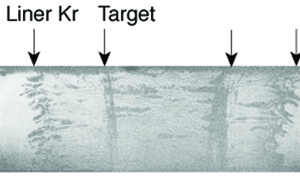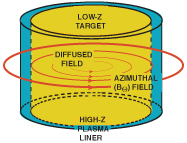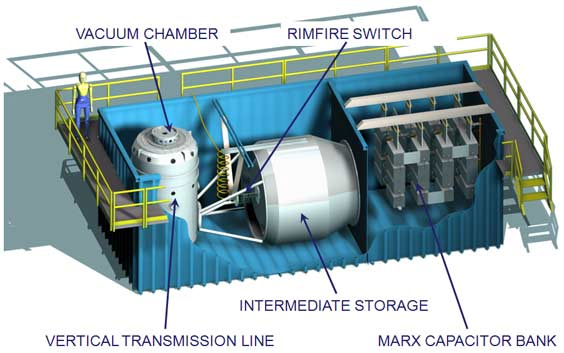



STAGED Z-PINCH
The Z pinch is one of the earliest approaches used to study thermonuclear fusion, due to its a relatively simple, pulse-power-driven, plasma-compression system, in which the azimuthal-magnetic field of a cylindrical-plasma discharge is used to compress the plasma by a self-generated JxB force. As the accumulated energy of the plasma converges to the axis and “thermalizes”, the Z pinch produces an intense burst of particles and X-rays; and neutrons, if the hydrogen isotopes of deuterium and tritium are used. Because of the high yield of nuclear events, produced by this reaction, and continuing over the past five decades, until today, the study of Z pinches has remained an active area of interest internationally, both for fundamental and applied studies of atomic-physics and controlled-thermonuclear fusion.
SCHEMATIC OF STAGED Z-PINCH The specific approach to the production of fusion energy in a staged Z-pinch that is studied by the principals of MIFTI involves “staging.” Basically, staging resets the clock on the energy accumulation in a fusible target, allowing it to be accumulated more efficiently and with greater power than using a conventional approach. Studies on experimental systems, using a microsecond implosion time, coupled with theoretical and computational analysis, provide solid evidence for the success of staging, and the potential for scaling this concept to fusion conditions. The approach is directed toward the production of a magnetically-accelerated, inertial-confined, high-energy-density pinch.
ZEBRA FACILITY A significant opportunity for this technology, which has not yet been disclosed by MIFTI principals, and remains proprietary, is the potential for the staged Z-pinch to be used to produce fusion, in an aneutronic reaction, using advanced fuels. Virtually all studies, to date, on fusion using Z-pinches has involved the use of deuterium and tritium fuels, which produce over 80% of its nuclear energy in the form of high energy neutrons. Neutrons are not preferred, since they induce radioactivity in the surrounding structure, and cannot be directed efficiently into an energy converter. With advanced fuels, for example; deuterium and helium-3, or hydrogen and boron-11, the nuclear reaction produces over 80% of its output in the form of charged particles that can be captured and directed into an efficient energy converter.
Depending on the specific choice of fuel, the nuclear energy could be collected from neutron producing reactions by a flowing liquid skirt of lithium on the outside of the pinch. The thermal energy of the liquid would then be converted into electricity by a thermal cycle. For the aneutronic reactions, the charged particles could be captured for direct conversion. These engineering challenges will be addressed, once the high gain fusion reaction is demonstrated.
Our experiments, theory, and computations agree well on the key dynamical features of the staged Z-pinch for producing fusion, which may be characterized as follows:
As the plasma liner implodes, a shock front is formed that detaches from the slower moving liner plasma. The shock collides with the outer surface of the low-mass, target plasma, accelerating it inward. The shock is partially transmitted and reflected at the interface. The shock speed in the target plasma is much larger than it is for the liner, thus the shock transit time in the target is short and the plasma is rapidly heated. Adiabatic compression and current amplification follow, as the bulk of the liner mass converges to the axis, compressing the plasma to fusion conditions. The quality of the fusion energy produced can be much larger than what was used to initially produce the reaction. Expressed in technical terms, there can be an energy gain (amplification) of fifty (50). To date, the scientific community has yet to produce a fusion reaction that comes close to an energy gain of one (1). In the video, produced by computer simulation, this is clearly demonstrated.
A significant opportunity for the Staged Z-pinch, that has not yet been disclosed by MIFTI Principals, and which remains corporate proprietary, is the potential for the Staged Z-pinch to be used to produce fusion in an a-neutronic reaction, using advanced fuels. Virtually all studies to date on fusion using Z Pinches has involved the use of deuterium and tritium fuels, which produces over 80% of its nuclear energy in the form of high energy neutrons. Neutrons are not preferred, since they induce radioactivity in the surrounding structure and cannot be directed efficiently into an energy converter. With advanced fuels, for example: deuterium and helium-3, or hydrogen and boron-11, the nuclear reaction produced over 80% of its output in the form of charged particles that can be captured and directed into an efficient-energy converter.
Depending on the specific choice of fuel, the nuclear energy could be collected for neutron producing reactions by a flowing liquid skirt of lithium on the outside of the pinch. The thermal energy of the liquid would then be converted into electricity by thermal cycle. For the aneutronic reactions the charged particles could be captured for direct conversion. These engineering challenges will be addressed once the high gain fusion reaction is demonstrated.
Our experiments, theory, and computations agree well on the key dynamical features of the Staged Z-pinch, for producing fusion, which may be characterized as follows. As the plasma liner implodes, a shock front is formed that detaches from the slower-moving liner plasma. The shock collides with the outer surface of the low-mass, target plasma, accelerating it inward. The shock is partially transmitted and reflected at the interface. The shock speed in the target plasma is much larger than it is for the liner, thus, the shock transit time in the target is short and the plasma is rapidly heated. Adiabatic compression and current amplification follow, as the bulk of the liner mass converges to the axis compressing the plasma to fusion conditions. The quantity of fusion energy produced can be much larger than what was used to produce the reaction in the first place, and expressed in technical terms can have an energy gain (amplification) of 50. To date, the community has yet to produce a fusion reaction that comes close to an energy gain of 1. In the video produced by computer simulation shows this very clearly.